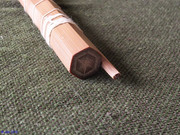Hi Justin, a number of years ago I made two MkIV's and one lighter version, the Mk IV Avon. I grew up in the UK and am familiar with the coarse fishing traditions there plus the writings of Walker and his pals of the 1950's: Venables, Taylor and BB.
The taper for the MkIV is most certainly in Walkers book- Rod Making for Amateurs (1953), listed as #8 - '10' rod for heavy carp, barbel, etc.' It is well known that Walker wanted a decent carp rod at a time when none were available, so he designed his own with the help of his friends The taper is referred to as being included (in his rod making book plus is described in detail) in Walker's book Still Water Angling.
The history of Walker, his catching of the 44lb record carp ' Clarissa' in 1952, plus the MkIV used has been very well documented. I suggest the 'Traditional Anglers' forum from the UK would be a good place to clarify any doubts of which of Walkers carp rods caught the record in those early days- those fellows chew over the subject constantly.
In 1980 Chris Yates went on to catch the next record carp from the same small pool (Redmire) which weighed 50lbs, on the lighter MkIV Avon, which Walker himself also had made. The full account by Yates of the capture was featured (along with a photo of the carp and rod) in Angling magazine, September 1980, of which I still have a copy.
The Mk 4 is quite a 'big' rod to make due to its larger lower section. Walkers original taper had a couple of feet of wooden dowel under the handle as he wanted it stiff in that section, then drilled a hole in the end, into which he glued the bamboo blank. I had the feeling that the lengths of bamboo culms available were shorter at the time, which may have explained this. In any case for mine I continued the taper into and through the handle. Were I to make another I would do this again, however I would add some long planed extra strips of bamboo bound to the outside of the blank under the handle to in effect, double build it there as I now do with all of my longer rods.
I used my regular forms to plane the sections. I marked up 6" stations using felt tipped pen, instead of the usual 5, just measuring at different points.It should be remembered that Walker himself did not use adjustable forms for his early, or possibly any, rods; instead gluing the bamboo strips to wooden 'formers' for planing, which probably gave a certain 'latitude' with the numbers..
The Mk IV is quite a 'beefy' rod with a fine tip, to cast those light baits and play heavy fish. I would not think it well suited to centre-pin style float fishing per se. I do not know where you are located or for which species you may be fishing for, but I would consider the Avon version more pleasant for general use although a little short at 10', I would be tempted to stretch it by adding a foot or so.
Finding the traditional fittings for the MkIV may be a challenge- the sliding rings, large agate lined lower ring, plus agate tip ring etc. I was fortunate to have a collection of parts. Hopkins & Holloway (UK) still make some very nice suitable chrome (unlined) tip rings with binding legs, plus bridge rings for the rest of the rod, Perfection(US) also make chrome spinning style bridge guides which have a slightly higher in profile and are a little heavier in the wire. The original handle was some 26" long which uses up a decent amount of cork, although it could be shortened. The ferrule will be tricky to find, Chapmans (UK) used to supply them, but I think they are not trading these days, finding the right size from a 'junker' salmon or coarse rod would do. I may have one when the time comes.
In any case, don't be daunted, the Mk Iv is quite a straightforward rod to make and an enjoyable one to use, however there is no need (in my opinion) to 'double build' as your photos show, if suitable bamboo is used. My only comment would be not try to cast baits which are too heavy. The taper is in four sections- stiff under the handle, steep taper just above, moderate middle section and steep again for the top few feet. It is where the steeper taper of the tip meets the more moderate taper below where 'casting sets' could set in, were the baits to be too heavy. Walker himself writes that the maximum weight the MkIV should cast would be around 1 1/2 oz.
One final note, simply deduct 10% from the MkIV taper to make the Avon MkIV.- that took a little research I remember at the time, but this was confirmed by a UK rod maker of my acquaintance.
Regards,
Malcolm
Photo shows the MkIV Avon, which I made for a friend of mine, being put to work..Plus the proud new owner of one of my MkIV's with a large barbel, in this instance used with a centre-pin reel.






